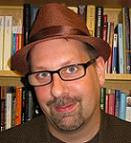
Fisk Time
(Warning: If you don't want details about the movie before seeing it (strongly advised), come back and read this only after you've helped make J.J. Abrams a few million bucks richer.)
Mr. Corliss's review begins like every other review, outlining the plot up until the time when the monster appears. Then:
Instantly you have a million questions. By which I mean: three. 1) Where did the creature come from? (The Hudson River? Or the Arctic, thawed out by climate change and sent south on tidal currents? Possibly Hoboken?) 2) What event roused it from a snooze that may date back to the dinosaur era? (Godzilla's rampage across Japan, you'll recall, was the spawn of atomic bombs dropped there.) 3) What, exactly, the heck is it?Indeed, but the immediate need for the main characters to simply survive suspends (or, anyway, postpones) the import of these questions. More on this later.
Can't say, since the movie -- written by Drew Goddard, from an idea by producer J.J. Abrams, and directed by Matt Reeves -- purports to be a video document "retrieved at an incident site formerly known as Central Park" (now known as Cloverfield), and is told exclusively from the point of view of a few twentysomethings. We know only what they know, see what the videocamera sees. I.e., not much."Not much"? Did you see the same movie I did? (Also, a minor correction: Cloverfield is not the new name for Central Park, it's the government codename for the monster. This is the first of Mr. Corliss's many inattentive errors.)
They gather at a surprise going-away party for young Rob Hawkins (Michael Stahl-David): his gal pal Lily (Jessica Lucas), his on-and-off girlfriend Beth (Odette Yustman), his best bud Hud (T.J. Miller) and a pretty stray named Lizzy (Marlene Diamond).Whoa, stop. First, Lily is Rob's brother's girlfriend, not his "gal pal." Second, his real gal pal (not "on-and-off girlfriend") is Beth, who he has been "just friends" with for a long time but has recently had sex with, putting their relationship in a state of confusion and flux. And third, there is no character named Lizzy and no actress named Marlene. There is, however, a character named Marlena portrayed by an actress named Lizzy Diamond. Seriously, dude, did you watch this movie?
Early on, Hud is given the job of documenting the event with a video camera. The movie spends its first 20 mins. introducing you to a bunch of people, most of whom will be dead by min. 30. All you have to know: Rob had a brief affair with Beth and wants to get back to her; Lily, although nobody hits on her, is a definite hottie; Lizzy is the disposable outsider; and Hud is the kind of guy who'll tag along to anything, including Armageddon. (Still, you have to give Hud credit. He may be running for his life for the 10 hrs. of the plot, but he never drops the camera or forgets to point it at the creatures that are ready to kill him. The guy's a trouper.)Lily is a definite hottie, but no one hits on her because she has a boyfriend. Who is with her. How do you miss this? The point about Hud never dropping the camera and filming everything is well taken, but it's just part of the suspension of disbelief required by this particular narrative device. Also: What happened to not being able to see much, eh?
They're all meant to be cool, attractive, upmarket young professionals -- Rob has just been promoted to vice president of some company that's sending him off to be in charge of Japan -- but their behavior is, tops, adolescent. The men in attendance clumsily hit on pretty girls they don't know; they mope about an old love (Beth) showing up with a new guy; they frantically pass along gossip about who's been sleeping with whom. A suspicion forms in viewers' minds that Cloverfield has been rated PG-13 "for the emotional age of the characters."Although Mr. Corliss's summary of the plot and relationships between the characters is again somewhat inaccurate, or at least badly contextualized, there is a fair criticism here. Not so much that the behavior of the twentysomethings is inconsistent with their age, but that their age is inconsistent with their environment. They live and move at the kind of social stratum (huge and hip urban lofts, jobs as vice presidents) that you would expect of people twice their age. The lingering mental impression is one of children trying on too-big adult clothing from mom and dad's wardrobe.
But their behavior is Noel Coward-sophisticate compared to what happens when the monster strikes. A horror/sf/disaster movie loses points every time you're forced to ask yourself, "Why are they doing something so stupid?," and the answer is, "Because they're in a horror/sf/disaster movie." And if you thought that Abrams -- the creator of Felicity, Alias and Lost and the writer-director of the spiffy if underperforming Mission: Impossible III -- would produce a horror movie that was not just high-concept but high-IQ -- you misjudge his faithfulness to a genre requiring that, in extremis, people act in a manner that's way below their intelligence levels.
 Every genre has its own particular conventions. You either accept them or you don't. Abrams and co. clearly did not set out to reinvent the monster movie (a point seemingly grasped by Mr. Corliss a few paragraphs below), only to give it a fresh, contemporary twist. This they have done. Yes, the characters in the film do sometimes behave in inexplicable ways. As always, you can mentally write off some of that to the old standby, "Well, how rational would you be in an emergency situation?" The rest of it? Well, again, it's a genre convention you accept or it's not your cup of tea. (I also hate and severely criticize when characters act very stupid in horror movies, but on the whole the behavior of the Cloverfield yuppies is, in monster-movie terms, not nearly as dumb or irrational as Mr. Corliss makes it sound. Uniformly competent acting helps here tremendously.)
Every genre has its own particular conventions. You either accept them or you don't. Abrams and co. clearly did not set out to reinvent the monster movie (a point seemingly grasped by Mr. Corliss a few paragraphs below), only to give it a fresh, contemporary twist. This they have done. Yes, the characters in the film do sometimes behave in inexplicable ways. As always, you can mentally write off some of that to the old standby, "Well, how rational would you be in an emergency situation?" The rest of it? Well, again, it's a genre convention you accept or it's not your cup of tea. (I also hate and severely criticize when characters act very stupid in horror movies, but on the whole the behavior of the Cloverfield yuppies is, in monster-movie terms, not nearly as dumb or irrational as Mr. Corliss makes it sound. Uniformly competent acting helps here tremendously.)Susan Sontag described horror and science fiction as "the imagination of disaster." The innovation is in thinking the unthinkable, not creating rounded or even plausible characters. In fact, human idiocy is a crucial aspect of a genre that trades in mortal threat. If the characters holed themselves away in some safe place, they'd never meet the monster. They have to be at risk in order to escape, or get trampled, and for us to get a cheap but essential movie thrill.Yes, Mr. Corliss, welcome to Storytelling 101, in which conflict must exist for there to be any story at all. And are you really quoting that well known authority on horror flicks, Susan Sontag? The woman who once said -- and seriously meant -- that "the white race is the cancer of human history"?
All right, sure, one really dumb quote does not sum up an entire person's thought or life, but let's be clear here. "Thinking the unthinkable" is indeed a prime ingredient for the best horror and science fiction stories, but nothing about that ingredient requires characters to be stupid or shallow. (Hello? Ever heard of Stephen King?) It is true, however, that many horror/SF movies do not necessarily put a premium on character development, and that's one of the reasons Cloverfield is distinctive: It does create an intimate atmosphere for the viewer to identify with a small (and ever-dwindling) group of characters. But then, as we've already seen, Mr. Corliss somehow completely missed all of this character development anyway. (I am picturing him in his theatre seat, taking one look, and sniffing, "Bah, just a bunch of damn kids at a damn party; wake me up when something explodes, preferably in proper Sontag-ian fashion.")
(Incidentally, Sontag's "On Photography" and "Notes on 'Camp'" as applied to Cloverfield and monster movies in general would probably at least yield more interesting mental masturbation, if that's your thing; in particular her notion of "viewing ethics" as it relates to the compulsive self-documentation of the Digital Age.)
Once the monster surfaces in Cloverfield, mobs of Manhattanites run for their lives across a bridge out of the borough. They. Are. Stupid! They, and you the viewer, are supposed to believe that this huge creature -- whose stride spans several city blocks, and who could get across the East River in about three steps -- is some sort of snob who wouldn't be caught dead in Brooklyn. (But his victims would. That tail whips out of the water and snaps the Brooklyn Bridge in two.)Let's think about this. You're a resident of a small, densely populated island that now sports a gigantic monster kicking the ever-loving shit out of everything. There are only a few escape routes, and the closest one to you leads to Brooklyn. You decide to head that way. Could the monster follow you there? Yes. Will it? Who knows? (It in fact never does leave Manhattan.) Will you still be on an island? Yes. But look at a map. Long Island is a hell of a lot bigger than Manhattan, so your chances of hiding from a giant asskicking monster are much improved over there. In this context, is the characters' decision to try the Brooklyn Bridge so self-evidently stupid? I don't think it is.
(All of this even assumes the average viewer, American or foreign, is acquainted with or cares about the bizarre geography of New York's five boroughs, which, I assure you, he or she likely is not and does not.)
Mr. Corliss draws comparisons with the alleged stupidity of heroic characters in other disaster films, then goes on:
Apocalyptic pessimism may be the theme of these movies, but the hero is driven by a desperate optimism: the world's ending, so I have to go on an impossible journey to save someone dear to me. The idea is that you'll forget about the tens of millions who died elsewhere and concentrate on the people you've come to know and have a rooting interest for. This elitism applies to virtually any movie set in cataclysmic times, whether it's the Civil War of Gone With the Wind or New-York-under-siege fantasies like Cloverfield. The leading characters become emblems of survival, and the movie proceeds under the theory that, in such a crazy world, the problems of a few little people really do amount to a hill of beans.Let me get this straight. Mr. Corliss, who could not keep track of six characters, and who thinks the filmmakers did a terrible job developing those six characters, believes it is a flaw of the movie that it did not feature millions of characters? And that the idea of having a manageable cast or a focused storyline is "elitism"?
This is so amazingly stupid I don't even know where to start. I guess back at Storytelling 101 again, where we previously re-learned that conflict is necessary to story and now apparently must re-learn the audience's need to identify with the characters. Can you identify with or emotionally invest in millions of characters? (Or, for that matter, can a storyteller develop millions of characters?) I don't think so. Josef Stalin is supposed to have said, "The death of one man is a tragedy; the death of millions is a statistic." In regards to fiction, anyway, the mass murdering bastard (who was certainly an expert on the deaths of millions) is right.
So Rob and his posse head into the subway tunnels, hoping to elude Cloverzilla and get uptown alive. Here's where the movie's one inspiration kicks in. Earlier, we saw the monster shedding parasites that had attached themselves to its hide like barnacles. These dog-size, cricket-faced, crablike creatures can bound like kangaroos, stick to ceilings and attack people without so much as a "Boo!"Of course, this is where I ducked out to take a leak. Grrr.
Just about every other plot and effects element in Cloverfield is familiar. The movie is basically the 1954 Godzilla (itself a gloss on Ray Harryhausen's 1953 The Beast from 20,000 Fathoms, in which a prehistoric beast is roused by atomic tests to terrorize New York City) told in the style of, and with the characters from, The Blair Witch Project (but with a lot less internal cohesion; this could be called "The Blair Witch Reject"). The State [sic] of Liberty head comes from the poster for John Carpenter's Escape from New York (though that shot is not in the film). The little crab creatures are like the toy meanies in Gremlins. And when the main monster opens its mouth, you pretty much know there'll be a second, Alien-like set of teeth.Yes, exactly -- the movie isn't a re-invention of the genre, just a much-needed update. And I have no idea what he is comparing the crab creatures to. Gremlins? WTF? If you've ever played the video game Half-Life, they look kind of like the crab things from that, only bigger and nastier. And though I could be wrong, I have no memory of the monster having a second set of Alien-like teeth.
In its broader contours, Cloverfield evokes real-life horror. The Wall Street area already had its monster mash, on 9/11. So there's no way you can watch downtown panic and crumbling towers without it seeming a bit... familiar. Naturally the director says, he didn't want to diminish or exploit the residue of grief from 9/11. And, as the press notes inform us, "The visual effects teams even took care that the collapsing buildings in the film were older-looking structures that did not evoke the style of the structures that were attacked six years earlier." You're right, visual effects team. It doesn't bother a New Yorker to see a gorgeous landmark like the Woolworth or Empire State Building destroyed. Those things are too old anyway.Who cares what does or doesn't bother a New Yorker? It's a freaking movie. It's also 100% obvious what the movie is about, so anyone that sensitive to fictitious rampaging monsters that hate Manhattan can make an informed decision to stay home. The rest of us who don't particularly care -- and we are the vast majority -- can go enjoy ourselves.
Mind you, I don't begrudge the creators of even a junk-food movie like Cloverfield the fun they had demolishing New York one more time. The city is as irresistible to filmmakers as it is to terrorists, and for the same reason: it's an amazingly dense and compact symbol of power. Harryhausen, Carpenter, Abrams and the I Am Legend team, among many others, see a city ready to explode from its own ambitions and animosities, from all that compressed energy; they'll just give it a push into catastrophe. But I have to agree with my wife, who, when I told her about Cloverfield, sighed and said, "Couldn't somebody, just once, pick Chicago?"New Yorkers are normally all too happy to believe and act as if their city is the center of the universe. Well, this is the other side of that particular coin, isn't it? Suck it up, bitches.
Getting It
In direct opposition to Mr. Corliss's awful, sloppy (this is Time magazine?!) review, there is Todd Hertz's take in Christianity Today.
Millions of characters?
By filming a normally grand-scaled monster movie with the intimate and limited viewpoint of The Blair Witch Project, this J.J. Abrams (Alias, Lost) produced film brings intensity, freshness and a sense of personal danger to a genre that needed a kick start.Adolescents with no character development?
Now, this film is no character study. Honestly, we don't know Rob or Beth or Hud or the others intimately well, but they are written so you can identify with their bonds and motivations. Filmed at such an intimate level, we see the quiet moments of tragedy, of breaking down, of awkward silence, of uncontrolled panic and of stilted conversations that might be missed in wider narratives. These people and their emotions feel real—and so the unreal they experience becomes more relatable.Unanswered questions about the monster?
You may be surprised that I've barely even addressed the monster. That's because the movie isn't really about the monster. It's about the reaction to him.
 THANK YOU, Mr. Hertz, for grasping the fundamental (but apparently very difficult to grasp) principle behind some of the best science fiction and horror.
THANK YOU, Mr. Hertz, for grasping the fundamental (but apparently very difficult to grasp) principle behind some of the best science fiction and horror.Cloverfield does feature a number of plot holes and inconsistencies, but in the end, it delivers what people who go to these kinds of movies want: thrills, chills, scares, and the feeling that they were well entertained for an hour and a half. At least it did in my case.











|